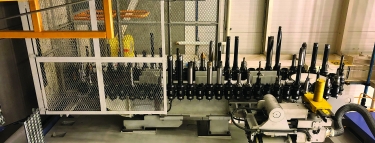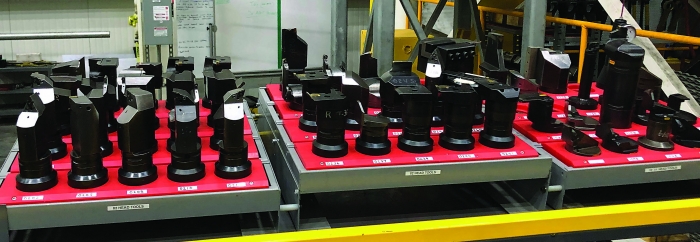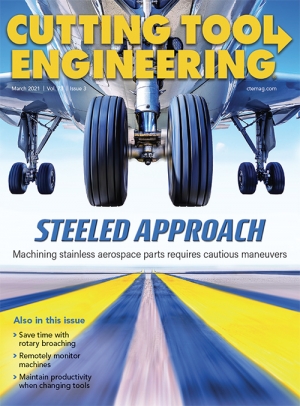Machine tools that are not running hurt productivity. There are reasons why machinists have to stop machines, such as to check dimensions, load parts or make adjustments. However, stopping a machine to deal with cutting tools unnecessarily interrupts production. Tasks like checking sharpness, changing tools, measuring tool offset data and adjusting size can be performed outside the machine, thereby improving productivity and reducing costs.
Cutting tools are the foundation of the machining process, and success requires using good tools that are cared for properly. Therefore, machinists spend a great deal of time checking and changing cutting tools. The most frequent activity is examining the cutting edge of tools to ensure they are still sharp. Although each machinist has a slightly different approach when inspecting cutting tools, one thing is certain: The machine is stopped while the tool is checked.
Modern Machines
Modern machine tools with toolchangers and tool life management systems offer several ways to overcome the need to stop machines for tool inspections. A simple method is to count the number of parts that have been machined. This is especially easy with large production volumes and repeating part configurations. Monitor the cutting tool, noting the number of completed parts when it has reached the end of its life, and set the machine to notify you when tools must be changed. Another option is a timer. As indicated by its name, a timer measures the amount of time that a tool has been in the spindle. When the predetermined time expires, the control notifies the machinist to change the tool. Timers are a good choice when production volumes are low and part configurations vary significantly.

Mitsubishi Hitachi Power Systems Americas stores a large number of tools in horizontal boring mills, reducing the risk associated with moving tools in and out of a machine. Image courtesy of C. Tate
Counters and timers are effective and easy to use but can have drawbacks. Monitoring the spindle load to determine edge condition is more accurate. Devices capable of sensing changes in amperage can be used to determine when a tool has reached the end of its useful life. As cutting edges wear, spindles consume more energy. When the maximum spindle load for a tool has been reached, the control discontinues use of the tool. These devices are the most accurate and offer the most flexibility, but they are also expensive and require someone to develop a set of parameters for each tool.
Collecting and entering tool data harms productivity too. When I started programming and setting up machine tools, each cutting tool would be touched to a datum until all offsets were entered. There were more efficient ways, such as using presetters and probes, to gather and store tool data, but small shops like ours could not afford those methods. Tool setting cost us many hours of lost productivity.
Things are different today. Machine tools with tool setting probes are common, and the cost is minimal. I suspect that all machine tool manufacturers offer tool probes as an option, which was not the case even just a few years ago. Using a tool probe interrupts production, but the impact is less significant than having a person measure and enter each value. A machine often has a macroprogram that allows the machinist to enter a few pieces of data, and the machine then autonomously measures the tools and stores the data.
Tool probes are invaluable when a shop wants to run lights out. One broken tool can ruin an entire run of parts. Successful autonomous operation requires the ability to detect broken tools, and tool probes can be used to detect breakage and signal a machine to stop. In several seconds, the machine can probe the tool and determine whether the stored offset data and the measured data are different before responding accordingly, which prevents scrap and rework.

Mitsubishi Hitachi Power Systems Americas opted for Capto toolholders, eliminating the need to set a tool each time it is changed. Image courtesy of C. Tate
For many years, using offline tool presetters has been a common method of obtaining tool data. A tool typically is measured at the presetter, and a machinist enters the data into the control. This approach has two major flaws. First and more significantly, entering data by hand risks putting in incorrect data, also known as fat fingering. Such mistakes can cause scrap, machine tool damage and undetected geometry errors that are not found until much later. Second, the machine almost always is stopped while the activities occur, impacting productivity.
Technology Today
Modern tool presetters are capable of transferring tool data from presetters to machine controls, eliminating the need for a machinist to enter data at the control. In some instances, the presetter is connected to the control in a network-type configuration in which each device reads and writes to a database or directly to the machine control. In other cases, tool data is saved on readable chips that are installed in the toolholders and read each time the machine loads the tool. The capabilities of presetters today combined with modern toolchangers allow all aspects of tool data management to be performed without machinist intervention.
The holy grail of tool management is the integration of tool storage, tool data transfer and tool condition monitoring. The most sophisticated systems enable machines to operate continuously while cutting tools are managed in the background. Cutting tools are assembled and measured offline as the data is transferred autonomously to the control. Inside the machine, cutting tools are monitored for wear or breakage, and the machine is programmed to use redundant tools. Used tools are cycled out so new ones can be set up and installed — all while the machine continues to process parts without interruption.
Although this ideal tool management arrangement is necessary only for high-volume shops, many of the components can be employed in low-volume environments to enhance productivity. Some of the hardware, such as presetters, can be prohibitively expensive, but many of the tool life monitoring tools are included in controls or can be installed at low cost. There are many ways to reduce the loss of productivity associated with cutting tool management.
Related Glossary Terms
- boring
boring
Enlarging a hole that already has been drilled or cored. Generally, it is an operation of truing the previously drilled hole with a single-point, lathe-type tool. Boring is essentially internal turning, in that usually a single-point cutting tool forms the internal shape. Some tools are available with two cutting edges to balance cutting forces.


